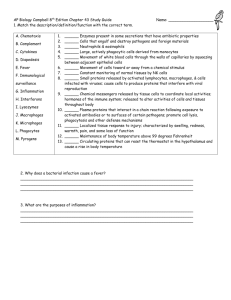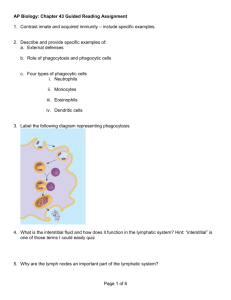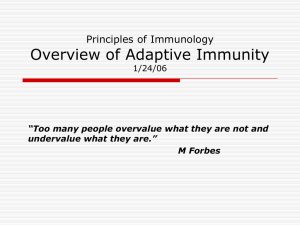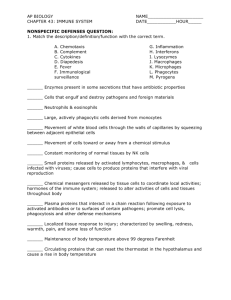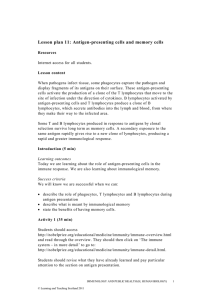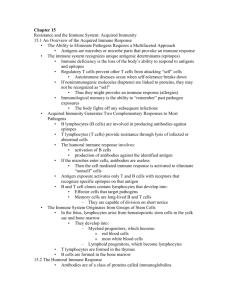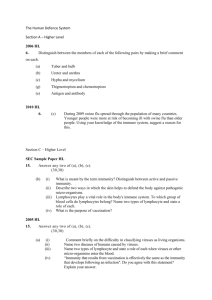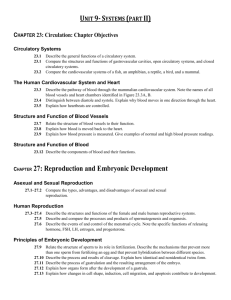Immune notes (extra help) - Fort Thomas Independent Schools
advertisement
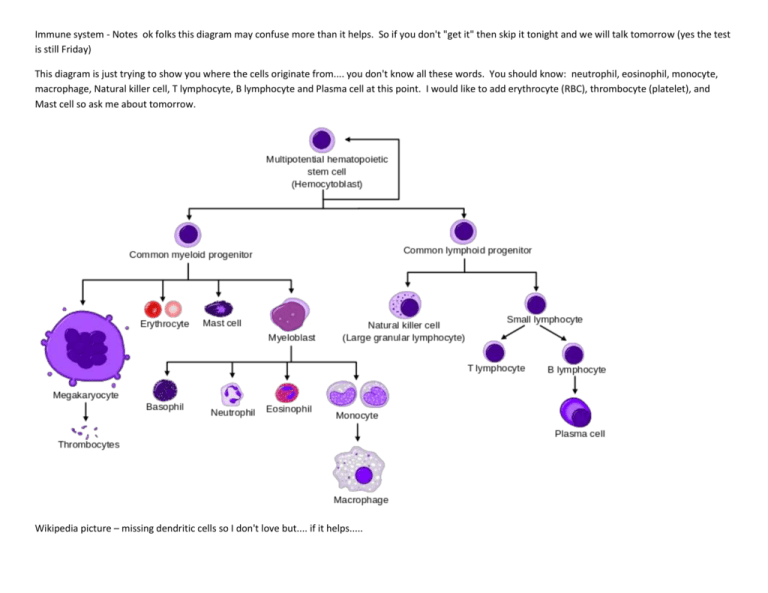
Immune system - Notes ok folks this diagram may confuse more than it helps. So if you don't "get it" then skip it tonight and we will talk tomorrow (yes the test is still Friday) This diagram is just trying to show you where the cells originate from.... you don't know all these words. You should know: neutrophil, eosinophil, monocyte, macrophage, Natural killer cell, T lymphocyte, B lymphocyte and Plasma cell at this point. I would like to add erythrocyte (RBC), thrombocyte (platelet), and Mast cell so ask me about tomorrow. Wikipedia picture – missing dendritic cells so I don't love but.... if it helps..... Immune system cell definitions (pink really was for me so ignore): Adaptive immunity- Lymphoid progenitor Lymphocytes is a White blood cells/leukocytes Agranulocytes (really have granules but not like granulocytes) 1. B Cell – make antibodies and also antigen-specific receptor-antibody (from bone marrow) Memory B cells Plasma cells – from B cells – a “factory” for producing the specific antibody 2. T Cell – several types – (from thymus gland) they can only recognize an antigen after the antigen is processed and presented to it by a socalled antigen-presenting cell (like a macrophage), in combination with a special type of cell marker (MHC – major histocompatibility complex). The T cell receptor only has one binding site unlike antibody that has two…. CD4 – helper T cells– bind antigen presented by antigen-presenting cells via T-cell receptor interacting with MCH II complex on APC. These cells help coordinate the immune response. CD8 – cytotoxic T cells– directly contact infected cells or tumor cells and destroy them. They bind antigens presented on MHC I Innate immunity – Myeloid Progenitor(precursor) Platelets – also called a thrombocyte – are a cell fragment in blood that helps clot the blood White blood cells/leukocytes: Granulocytes: 1. Eosinophil – white blood cell develop from bone marrow and travel to inflamed tissue – inflammatory response (can be caused by parasites ...large pathogens like protists, flukes etc.)– activated by helper T cells – also allergy response 2. Neutrophil – WBC that attacks bacteria or fungi, circulate in the blood, but can move into tissues when needed (pus is primarily these cells) 3. Basophil –- least common WBC – contain histamine (chemical that is a vasodilator - that can cause symptoms of an allergic reaction) –also contain heparin – which is an anticoagulant (prevents blood clotting to quickly). These cells are in blood but can move into tissues when needed Agranulocytes (really do have granules but not like above) 1. See other side 2. Monocytes – circulates in blood will migrate to differentiate to become macrophage 3. Macrophages - in tissues throughout the body, engulfs pathogens and initiates lymphocyte production. Memory T Cells (from both CD4 and CD8) *all nucleated cells (meaning body cells) have MHC I on their surfaces. 3. NK cell – Natural killer cells - from adaptive/ lymphoid but goes to innate response. They do not have a specific recognition, but target foreign targets and use chemicals to “kill” (so the targeted cell has lost it’s MHC I molecule, b/c they are infected with a virus or have become cancerous). 4. suppressor T cell – turn off or suppress immune cells Dendritic cell - Can be myeloid or lymphoid derived. Main function is as an antigen-presenting cell (APC) that activates T lymphocytes, That is they act as messengers between the innate and adaptive immunity. Only in mammals – several types – skin, nose, lungs…. Mast cell – rich in histamine and heprin (like basophils) Other definitions: Antibody – large protein molecules that belong to a group called immunoglobulins. Composed of Heavy and light chains, in the shape of a Y. The “tips” of the Y are specific and recognize the antigen. The stem of the Y links to other cells in the immune system (ex. B cells that are expressing the antibody). Antigens - are macromolecules are macromolecules such as proteins and polysaccharides (sugars) that are recognized as foreign by the adaptive immune system. T cells, B cells, and antibodies do not recognize entire antigen molecules. Rather, they recognize a small portion of the molecule known as an epitope. A large antigen may have multiple epitopes, each of which is recognized by the surface receptor on a specific clone of T cells or B cells, or by a specific antibody molecule. phagocyte – large white blood cells that can engulf and digest foreign invaders Ok two words probably causing confusion: Cytokine vs. Chemokine Cytokines and chemokines are both small proteins made by the immune system to attack foreign invaders; both proteins will act on the system target cells, but only chemokines control the chemotaxis (meaning??? hopefully you can answer this???) of leukocytes. cytokine and a chemokine are both small proteins made by cells in the immune system. They are important in the production and growth of lymphocytes, and in regulating responses to infection or injury such as inflammation and wound healing. Cytokines are the general category of messenger molecules, while chemokines are a special type of cytokine that direct the migration of white blood cells to infected or damaged tissues. Both use chemical signals to induce changes in other cells, but the latter are specialized to cause cell movement. Wikipedia (condensed): Cytokines (Greek:Cyto "cell" + Kines from Greek " kinisi "movement") are a broad and loose category of small proteins that are important in cell signaling. They are released by cells and affect the behavior of other cells, and sometimes the releasing cell itself. Cytokines include chemokines, interferons, interleukins. Cytokines are produced by a broad range of cells, including immune cells like macrophages, B lymphocytes, T lymphocytes and mast cells..... Interleukin are a group of cytokines ***They promote the development and differentiation of T and B lymphocytes MHC I and MHC II (see babyoutline) Interferon ***** I didn't get all the vocab so be sure to study the baby outlines!!! Image source: Immunobiology, 5th edition Janeway et al Phagocytes in the Body (specialized – depending where they are located) Just for extra help but you don't really need the above diagram Boston University School of Public Health B cell-mediated Immunity (a.k.a.Humoral or Antibody Mediated Immunity) provides protection against extracellular pathogens T cell-mediated Immunity (a.k.a.Cell Mediated Immunity) provides protection against intracellular pathogens Realize, however, that humoral and cell mediated immunity (i.e. responding B cells and T cells, respectively) work in concert to eliminate an infecting pathogen. For example, while antibodies generated by a B cell-mediated response are key in eliminating free, circulating viruses, T cellmediated immunity is key for destroying a virus once it is within a cell. When The Immune System Fails 1. Allergy 2. Autoimmune diseases 3. Cancer Allergy First exposure to an allergen B cells make large amounts of IgE antibodies. These IgE molecules attach to mast cells, (in lungs, skin, tongue, and linings of the nose and gastrointestinal tract) Next exposure to allergen mast cell releases chemicals causing wheezing, sneezing, and other symptoms of allergy.

